Themed collection Special issue in honour of Seth Marder

Editorial for the special issue of Materials Horizons in honor of Seth Marder
Jean-Luc Brédas, Zhenan Bao, Thuc-Quyen Nguyen, and Mark E. Thompson introduce the Materials Horizons special issue in honor of Seth Marder.

Mater. Horiz., 2022,9, 15-16
https://doi.org/10.1039/D1MH90068D
Halide perovskites scintillators: unique promise and current limitations
The origins of the remarkable performance of halide perovskite scintillators are presented, along with solutions to the challenges facing the field, followed by a discussion of applications that will benefit from the unique properties of these materials.
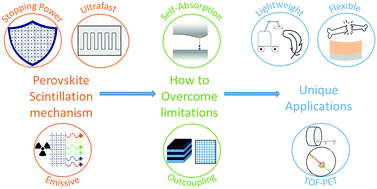
J. Mater. Chem. C, 2021,9, 11588-11604
https://doi.org/10.1039/D1TC01595H
Preventing phase segregation in mixed-halide perovskites: a perspective
Halide segregation represents a severe stability problem for certain mixed-halide perovskites. Here we explore a myriad of methods for mitigating halide segregation, including several largely unexplored approaches that show significant promise.
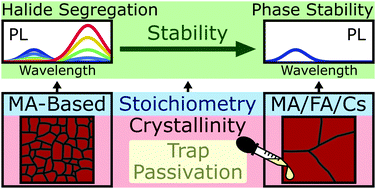
Energy Environ. Sci., 2020,13, 2024-2046
https://doi.org/10.1039/D0EE00788A
Conquering residual light absorption in the transmissive states of organic electrochromic materials
Using a feedback loop between computational modeling probing electronic transitions and experimental work, the colors, transmissivity, and redox switching properties of a family of anodically coloring electrochromic molecules are reviewed.
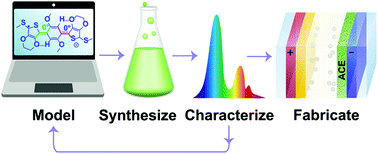
Mater. Horiz., 2022,9, 252-260
https://doi.org/10.1039/D1MH01136G
Soft skin layers for reconfigurable and programmable nanowrinkles
This Mini-review highlights reconfigurable nanowrinkles based on polymer skin layers and how they enable hierarchical structuring of thin functional materials.
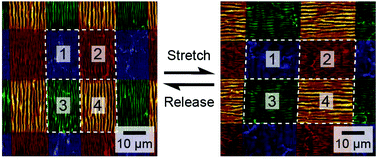
Nanoscale, 2020,12, 23920-23928
https://doi.org/10.1039/D0NR07054H
Organic building blocks at inorganic nanomaterial interfaces
Inorganic–organic interfaces: a tutorial on using organic functional groups to enhance the performances and/or enable new functionality of inorganic nanomaterials.
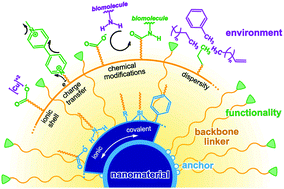
Mater. Horiz., 2022,9, 61-87
https://doi.org/10.1039/D1MH01294K
Engineering of flat bands and Dirac bands in two-dimensional covalent organic frameworks (COFs): relationships among molecular orbital symmetry, lattice symmetry, and electronic-structure characteristics
An effective framework for the band engineering in 2D covalent organic frameworks is revealed by describing the fundamental relationships among the electronic structures, the lattice symmetries, and the frontier molecular orbitals of building units.
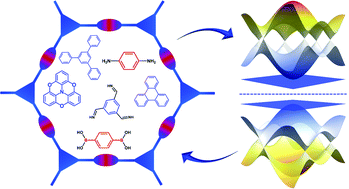
Mater. Horiz., 2022,9, 88-98
https://doi.org/10.1039/D1MH00935D
Scattering techniques for mixed donor–acceptor characterization in organic photovoltaics
The effects of mixing in organic photovoltaics are unclear partly due to challenges in characterization. X-Ray and neutron scattering techniques have been successful in quantifying mixing but meet new challenges with emerging non-fullerene systems.
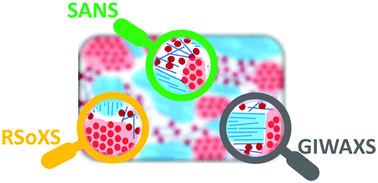
Mater. Horiz., 2022,9, 43-60
https://doi.org/10.1039/D1MH01219C
Plasmons: untangling the classical, experimental, and quantum mechanical definitions
Plasmons have been widely studied over the past several decades because of their ability to strongly absorb light and localize its electric field on the nanoscale, leading to applications in spectroscopy, biosensing, and solar energy storage.
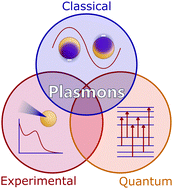
Mater. Horiz., 2022,9, 25-42
https://doi.org/10.1039/D1MH01163D
Electronic properties of metal halide perovskites and their interfaces: the basics
Metal halide perovskites exhibit complex electronic properties. The presently identified fundamental concepts and phenomena governing the electronic behavior of this material class are addressed in this article.
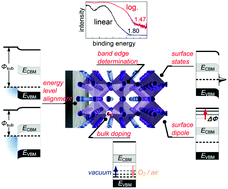
Mater. Horiz., 2022,9, 17-24
https://doi.org/10.1039/D1MH01106E
Narrowband organic photodetectors – towards miniaturized, spectroscopic sensing
Organic photodetectors can achieve narrowband photodetection within a single optoelectronic device. This comprehensive review summarizes and compares the different approaches, introduces their application fields, and outlines current challenges.

Mater. Horiz., 2022,9, 220-251
https://doi.org/10.1039/D1MH01215K
Printing fabrication of large-area non-fullerene organic solar cells
This review summarizes the fabrication technology and recent progress of large-area organic solar cells based on non-fullerene electron acceptors.
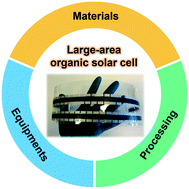
Mater. Horiz., 2022,9, 194-219
https://doi.org/10.1039/D1MH01317C
Molecular bases for temperature sensitivity in supramolecular assemblies and their applications as thermoresponsive soft materials
This review summarizes the recent advances in thermoresponsive supramolecular assemblies and the molecular level factors and parameters that can be tuned to achieve optimal responses for a variety of applications.
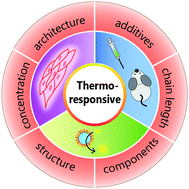
Mater. Horiz., 2022,9, 164-193
https://doi.org/10.1039/D1MH01091C
Advances in materials and devices for mimicking sensory adaptation
This review summarizes the main concepts, recent developments, and several strategies for mimicking sensory adaptation; challenges and perspectives in this emerging field are also proposed.
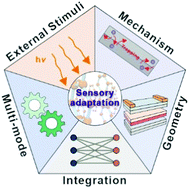
Mater. Horiz., 2022,9, 147-163
https://doi.org/10.1039/D1MH01111A
Modulating the optical properties and functions of organic molecules through polymerization
This review summarizes recent progress in the occurrence, mechanism and application for some of the materials with optical properties that are significantly improved through polymerization.
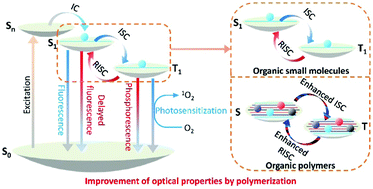
Mater. Horiz., 2022,9, 99-111
https://doi.org/10.1039/D1MH01030A
Design strategies for improving the crystallinity of covalent organic frameworks and conjugated polymers: a review
This review summarizes the strategies for improving the crystallinity of covalent organic frameworks and conjugated polymers. The strategies include planarity modulation, fluorine substitution, side chain engineering, and so on.
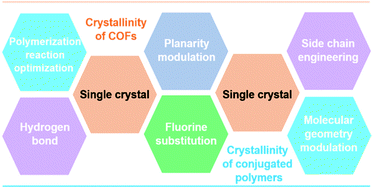
Mater. Horiz., 2022,9, 121-146
https://doi.org/10.1039/D1MH00809A
Applications of triarylborane materials in cell imaging and sensing of bio-relevant molecules such as DNA, RNA, and proteins
This review highlights recently developed biological applications of triarylboranes in cell imaging and as sensors for DNA, RNA, proteins, and bio-relevant small molecules using 1- and 2-photon excited fluorescence, Raman, and SERS.
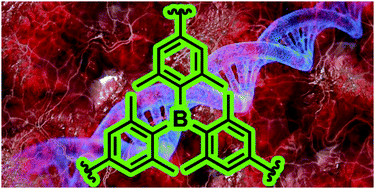
Mater. Horiz., 2022,9, 112-120
https://doi.org/10.1039/D1MH00696G
Harnessing selectivity in chemical sensing via supramolecular interactions: from functionalization of nanomaterials to device applications
We review the design and fabrication of selective chemical sensors based on low-dimensional materials functionalized with (supra)molecular receptors, from the choice of the analyte of interest to its final device integration.
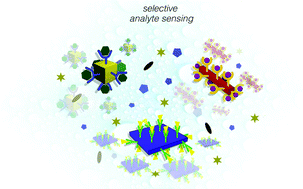
Mater. Horiz., 2021,8, 2685-2708
https://doi.org/10.1039/D1MH01117K
Martensitic transition in molecular crystals for dynamic functional materials
This review comprehensively summarizes fundamentals and potential applications of molecular martensites – an emerging class of dynamic crystals for next-generation smart functional materials.
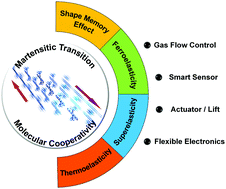
Chem. Soc. Rev., 2020,49, 8287-8314
https://doi.org/10.1039/D0CS00638F
The damaging effects of the acidity in PEDOT:PSS on semiconductor device performance and solutions based on non-acidic alternatives
Poly(3,4-ethylenedioxythiophene):poly(styrene sulfonate), PEDOT:PSS, has been widely used as an effective hole transporting material in many different organic semiconductor devices for well over a decade.
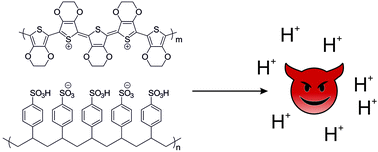
Mater. Horiz., 2020,7, 1759-1772
https://doi.org/10.1039/C9MH01978B
About the amplification factors in organic bioelectronic sensors
A systematic comparison between electrochemical and organic bioelectronic sensors reveals a unified rational description for a transistor amplified detection.
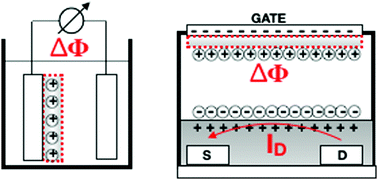
Mater. Horiz., 2020,7, 999-1013
https://doi.org/10.1039/C9MH01544B
Universal electrode for ambipolar charge injection in organic electronic devices
Ambipolar transistors, i.e. transistors with symmetrical n- and p-type performances, open new avenues for the design and integration of high-density, efficient and versatile circuits for advanced technologies.
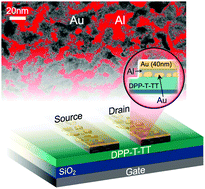
Mater. Horiz., 2022,9, 2138-2146
https://doi.org/10.1039/D1MH01845K
Hybrid fabrication of multimodal intracranial implants for electrophysiology and local drug delivery
New fabrication approaches for mechanically flexible implants hold the key to advancing the applications of neuroengineering in fundamental neuroscience and clinic.

Mater. Horiz., 2022,9, 1727-1734
https://doi.org/10.1039/D1MH01855H
Propylene and butylene glycol: new alternatives to ethylene glycol in conjugated polymers for bioelectronic applications
Propylene and butylene glycol oligoether chains have been employed as alternatives to ethylene glycol in thiophene based semiconductors for OECTs. Their impact on electrochemical, microstructure, and swelling properties are discussed.
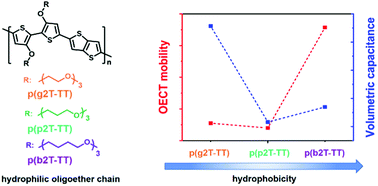
Mater. Horiz., 2022,9, 973-980
https://doi.org/10.1039/D1MH01889B
Structural insights into Lewis acid- and F4TCNQ-doped conjugated polymers by solid-state magnetic resonance spectroscopy
Polymer–dopant intermolecular interactions characterized by solid-state NMR and EPR spectroscopy techniques offer clues about the different doping mechanisms and efficiencies.
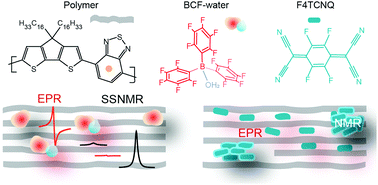
Mater. Horiz., 2022,9, 981-990
https://doi.org/10.1039/D1MH01574E
Discovering structure–property relationships for the phonon band structures of hydrocarbon-based organic semiconductor crystals: the instructive case of acenes
A systematic analysis of the phonon bands calculated using dispersion-corrected density functional theory for crystalline acenes reveals analogies between the phonons and classical oscillator models. Based on these, the evolution of the materials’ properties can be rationalised.

J. Mater. Chem. C, 2022,10, 2532-2543
https://doi.org/10.1039/D1TC04708F
Enhanced emission by stacking of crown ether side chains in a 2D covalent organic framework
2D hydrazone-linking covalent organic frameworks with differently sized crown ether side chains were synthesized, and 20-fold improved emission was achieved by tuning the size of the crown ethers.

Chem. Commun., 2022,58, 1302-1305
https://doi.org/10.1039/D1CC03409J
Backbone-driven host–dopant miscibility modulates molecular doping in NDI conjugated polymers
Molecular doping is the key to enabling organic electronic devices, however, the design strategies to maximize doping efficiency demands further clarity and comprehension.
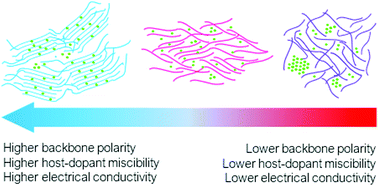
Mater. Horiz., 2022,9, 500-508
https://doi.org/10.1039/D1MH01357B
Peculiar anharmonicity of Ruddlesden Popper metal halides: temperature-dependent phonon dephasing
The anharmonicity of the Ruddlesden Popper metal-halide lattice, and its consequences for their electronic and optical properties, are paramount in their basic semiconductor physics.
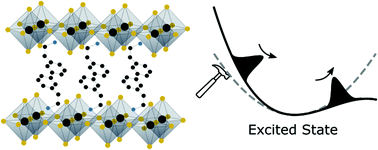
Mater. Horiz., 2022,9, 492-499
https://doi.org/10.1039/D1MH01010G
Bipolarons rule the short-range terahertz conductivity in electrochemically doped P3HT
In situ terahertz spectroscopy on electrochemically doped P3HT reveals the impact of polarons and bipolarons on the short-range conductivity.
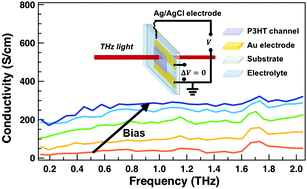
Mater. Horiz., 2022,9, 482-491
https://doi.org/10.1039/D1MH01343B
Rationalizing energy level alignment by characterizing Lewis acid/base and ionic interactions at printable semiconductor/ionic liquid interfaces
Chemical and ionic interactions between an ionic liquid and printable semiconductors are probed by photoelectron spectroscopy, with increasing reactivity associated with underlying defects from P3HT to NiOx to PbS/PbIx quantum dots to MAPbI3.
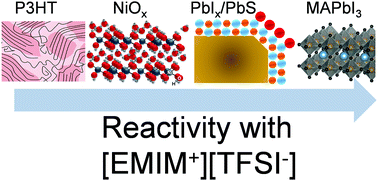
Mater. Horiz., 2022,9, 471-481
https://doi.org/10.1039/D1MH01306H
Photopolymerized superhydrophobic hybrid coating enabled by dual-purpose tetrapodal ZnO for liquid/liquid separation
Dual purposed ZnO tetrapods promote photopolymerization of methacrylates and provide surface roughness for superhydrophobicity. Large area photochemical fabrication of hybrid coating is demonstrated for liquid/liquid separation applications.
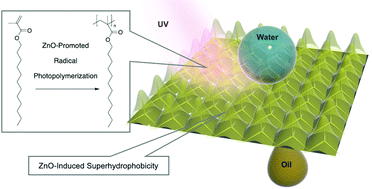
Mater. Horiz., 2022,9, 452-461
https://doi.org/10.1039/D1MH01672E
Tuning of the elastic modulus of a soft polythiophene through molecular doping
Molecular doping of a polythiophene with oligoethylene glycol side chains is found to strongly modulate not only the electrical but also the mechanical properties of the polymer.
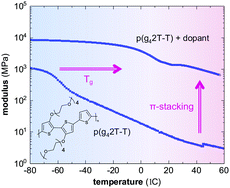
Mater. Horiz., 2022,9, 433-443
https://doi.org/10.1039/D1MH01079D
Short and long-range electron transfer compete to determine free-charge yield in organic semiconductors
Marcus theory explains photoinduced electron transfer from donor molecules to a fullerene host when all microstates are included, and formation of free charge competes with charge-transfer states.

Mater. Horiz., 2022,9, 312-324
https://doi.org/10.1039/D1MH01331A
Printing dynamic color palettes and layered textures through modeling-guided stacking of electrochromic polymers
A stacking scheme for solution-processable electrochromic polymers is presented with the integration of direct photolithography patterning to realize full colors, layered textures, and controllable color switching.
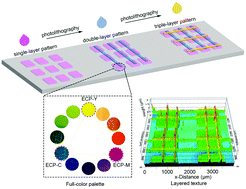
Mater. Horiz., 2022,9, 425-432
https://doi.org/10.1039/D1MH01098K
Facilitating the acidic oxygen reduction of Fe–N–C catalysts by fluorine-doping
We report a F-doped FeNC catalyst with improved ORR performance. The enhanced performance is associated with the large BET surface area, abundant single Fe atoms, and strong electron-withdrawing F-doping.
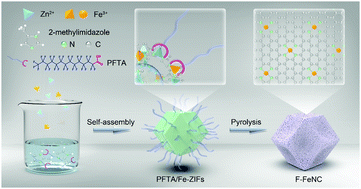
Mater. Horiz., 2022,9, 417-424
https://doi.org/10.1039/D1MH01307F
Cryogenic electron tomography to determine thermodynamic quantities for nanoparticle dispersions
Nanoparticle dispersions were studied by cryogenic electron tomography, which was found to allow extraction of key thermodynamic quantities.

Mater. Horiz., 2022,9, 303-311
https://doi.org/10.1039/D1MH01461G
Enantiopure 2-(2-ethylhexyl)dinaphtho[2,3-b:2′,3′-f]thieno[3,2-b]thiophenes: synthesis, single-crystal structure and a surprising lack of influence of stereoisomerism on thin-film structure and electronic properties
Starting from a chiral resolution of 2-ethylhexanoic acid followed by conversions of functional groups without interfering with the enantiopurity, we have successfully introduced an enantiopure 2-ethylhexyl group on to dinaphtho[2,3-b:2′,3′-f]thieno[3,2-b]thiophene (DNTT) via a Negishi-coupling reaction to synthesize 2-(R)-(2-ethylhexyl)- and 2-(S)-(2-ethylhexyl)-DNTT (R- and S-EH-DNTT, respectively).
![Graphical abstract: Enantiopure 2-(2-ethylhexyl)dinaphtho[2,3-b:2′,3′-f]thieno[3,2-b]thiophenes: synthesis, single-crystal structure and a surprising lack of influence of stereoisomerism on thin-film structure and electronic properties](/en/Image/Get?imageInfo.ImageType=GA&imageInfo.ImageIdentifier.ManuscriptID=D1MH01119G&imageInfo.ImageIdentifier.Year=2022)
Mater. Horiz., 2022,9, 444-451
https://doi.org/10.1039/D1MH01119G
Singlet fission and triplet pair recombination in bipentacenes with a twist
We investigate triplet pair dynamics in pentacene dimers that have varying degrees of coplanarity (pentacene–pentacene twist angle).
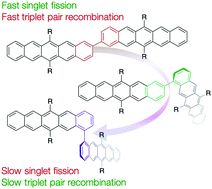
Mater. Horiz., 2022,9, 462-470
https://doi.org/10.1039/D1MH01201K
Organic single crystals of charge-transfer complexes: model systems for the study of donor/acceptor interactions
Polymorphism in organic charge-transfer complexes induces a variation in electronic structure and sub-gap states which directly impact device physics. Single crystals are highly ordered, allowing for the measurement with reduced extrinsic factors.
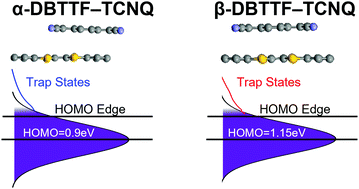
Mater. Horiz., 2022,9, 271-280
https://doi.org/10.1039/D1MH01214B
Planar refractive index patterning through microcontact photo-thermal annealing of a printable organic/inorganic hybrid material
We demonstrate proof-of-concept refractive-index structures with large refractive-index-gradient profiles, using a rapid micro-contact photothermal annealing (μCPA) process to pattern a novel organic/inorganic hybrid materials family.
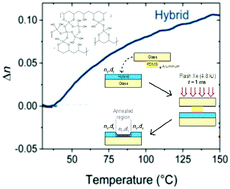
Mater. Horiz., 2022,9, 411-416
https://doi.org/10.1039/D1MH01366A
Regiospecific N-alkyl substitution tunes the molecular packing of high-performance non-fullerene acceptors
Single-crystals of a series of Bz-based NFAs derivatized via regiospecific N-alkyl engineering have been systematically studied. The J-aggregate-like packing in EHN6SEH-4F facilitates formation of ordered 3D channels for efficient charge transport.
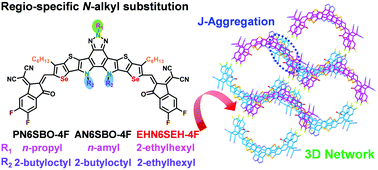
Mater. Horiz., 2022,9, 403-410
https://doi.org/10.1039/D1MH01127H
Excited states engineering enables efficient near-infrared lasing in nanographenes
Organic molecules usually exhibit optical gain losses in the NIR, due to the absorption of charged species/triplets. We report on a nanographene molecule in which the minimisation of such losses enable the achievement of low-threshold NIR lasing.

Mater. Horiz., 2022,9, 393-402
https://doi.org/10.1039/D1MH00846C
Design and synthesis of chromophores with enhanced electro-optic activities in both bulk and plasmonic–organic hybrid devices
By tuning donor strength, we produce an organic electro-optic chromophore with high hyperpolarizability, low absorption, and excellent electro-optic activity, which is demonstrated in a plasmonic–organic hybrid modulator with near record low VπL.
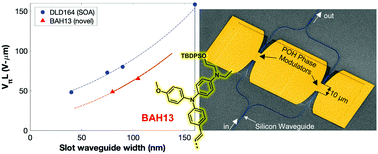
Mater. Horiz., 2022,9, 261-270
https://doi.org/10.1039/D1MH01206A
Tuning the donor–acceptor interactions in phase-segregated block molecules
A robust, soft material held together by charge transfer interactions is developed. The nanostructure dimensions and material properties can be tuned by molecular design or pressure.
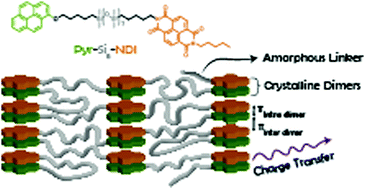
Mater. Horiz., 2022,9, 294-302
https://doi.org/10.1039/D1MH01141C
Crystalline tetra-aniline with chloride interactions towards a biocompatible supercapacitor
A biocompatible supercapacitor has been assembled by incorporating crystalline tetra-aniline as active electrode material via chloride electrochemical interaction.
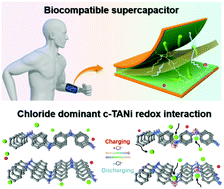
Mater. Horiz., 2022,9, 383-392
https://doi.org/10.1039/D1MH01081F
Direct intercalation of MoS2 and WS2 thin films by vacuum filtration
We report a versatile method to prepare intercalated transition metal dichalcogenides in a thin-film morphology. Metallocenes, alkylamines, and electron-proton transfer mediators are intercalated into MoS2 and WS2 using vacuum filtration.
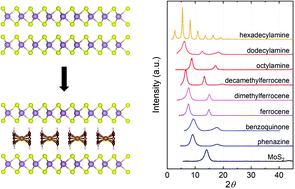
Mater. Horiz., 2022,9, 360-367
https://doi.org/10.1039/D1MH01193F
Multi-photoresponsive triphenylethylene derivatives with photochromism, photodeformation and room temperature phosphorescence
Multi-photoresponsive properties, including photochromism, photodeformation and room temperature phosphorescence, are achieved in triphenylethylene derivatives, which can be well tuned by variation of bromine substituents to phenyl moieties.
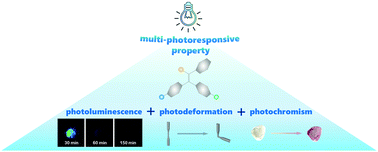
Mater. Horiz., 2022,9, 368-375
https://doi.org/10.1039/D1MH01207J
Design and synthesis of yellow- to red-emitting gold(III) complexes containing isomeric thienopyridine and thienoquinoline moieties and their applications in operationally stable organic light-emitting devices
A new class of yellow- to red-emitting carbazolylgold(III) complexes containing isomeric thienopyridine and thienoquinoline moieties in the cyclometalating ligand has been designed to realize high performance OLEDs with long operational lifetime.
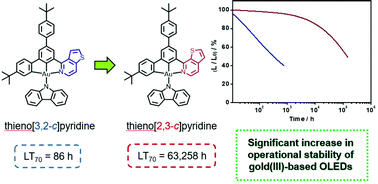
Mater. Horiz., 2022,9, 281-293
https://doi.org/10.1039/D1MH00821H
Aggregation-induced emission luminogen with excellent triplet–triplet upconversion efficiency for highly efficient non-doped blue organic light-emitting diodes
Highly efficient non-doped blue TTU-OLEDs were realized based on the AIEgens with excellent emission and upconversion efficiency in the film states.
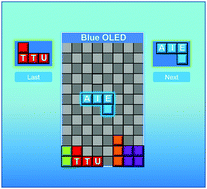
Mater. Horiz., 2022,9, 376-382
https://doi.org/10.1039/D1MH01129D
Substituent-dependent absorption and fluorescence properties of perylene bisimide radical anions and dianions
Custom-built flow cells for absorption and fluorescence spectroelectrochemistry provide details on optical transitions, transition dipole moments and fluorescence quantum yields of five perylene bisimides as well as their radical anions and dianions.
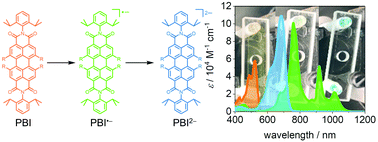
Mater. Horiz., 2022,9, 350-359
https://doi.org/10.1039/D1MH01019K
A computational scheme for evaluating the phosphorescence quantum efficiency: applied to blue-emitting tetradentate Pt(II) complexes
Phosphorescent organic light-emitting diodes (PhOLEDs) are leading candidates for displays or lighting technologies.
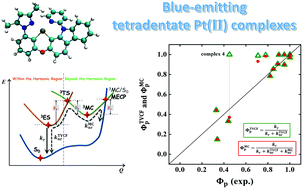
Mater. Horiz., 2022,9, 334-341
https://doi.org/10.1039/D1MH00552A
3D printing of artificial skin patches with bioactive and optically active polymer materials for anti-infection and augmenting wound repair
A printable ink composed of a photoactive cationic conjugated polymer (PPV) and gelatin/alginate/hyaluronic acid was developed for 3D printing artificial skin patches with the biofunctions of anti-infection and augmenting wound repair.
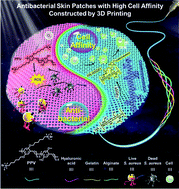
Mater. Horiz., 2022,9, 342-349
https://doi.org/10.1039/D1MH00508A
Lower limits for non-radiative recombination loss in organic donor/acceptor complexes
An emissive yet charge-generating organic donor/acceptor blend is demonstrated, which highlights the importance of electronic hybridization between the charge-transfer and local-exciton states to reduce non-radiative recombination loss.

Mater. Horiz., 2022,9, 325-333
https://doi.org/10.1039/D1MH00529D
Nanoribbons or weakly connected acenes? The influence of pyrene insertion on linearly extended ring systems
Pyrene moieties inserted among acene units do not result in long acene-like structures; rather the pyrene-inserted acene structure is, electronically, a series of (nearly) isolated acenes.
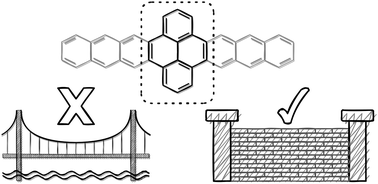
J. Mater. Chem. C, 2021,9, 16929-16934
https://doi.org/10.1039/D1TC05193H
Crystallization driven boost in fill factor and stability in additive-free organic solar cells
Post-processing the active layer in additive-free organic solar cells enabled an enhancement in performance due to an increased acceptor crystallinity, resulting in a fill factor of 76%, a power conversion efficiency of 13.84% and an improved stability.
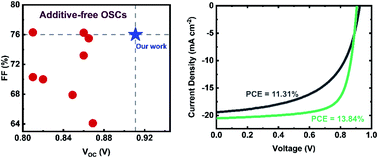
J. Mater. Chem. A, 2021,9, 23783-23792
https://doi.org/10.1039/D1TA08232A
Inter-capsule fusion and capsule shell destruction using dynamic covalent polymers
Herein, capsule shells containing hindered urea bonds were prepared using interfacial polymerization in an oil-in-oil Pickering emulsion stabilized by functionalized graphene oxide nanosheets.
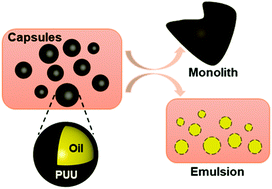
Polym. Chem., 2021,12, 2695-2700
https://doi.org/10.1039/D1PY00271F
Bridging the thermodynamics and kinetics of temperature-induced morphology evolution in polymer/fullerene organic solar cell bulk heterojunction
Organic solar cell morphology evolution through distinct and consecutive spinodal decomposition and nucleation and growth mechanisms.
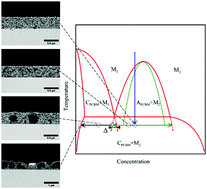
Mater. Horiz., 2021,8, 1272-1285
https://doi.org/10.1039/D0MH01805H
Ambient blade coating of mixed cation, mixed halide perovskites without dripping: in situ investigation and highly efficient solar cells
Blade coating of mixed cation, mixed halide perovskite films is investigated using in situ X-ray scattering to investigate the role of formulations and processing routes and eliminate the need for anti-solvent dripping.
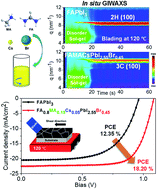
J. Mater. Chem. A, 2020,8, 1095-1104
https://doi.org/10.1039/C9TA12890E
Charge transport through extended molecular wires with strongly correlated electrons
Experimental studies of electron transport through an edge-fused porphyrin oligomer in a graphene junction are interpreted within a Hubbard dimer framework.
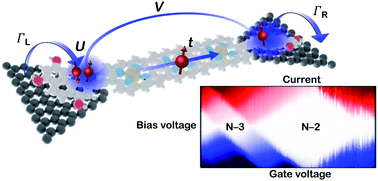
Chem. Sci., 2021,12, 11121-11129
https://doi.org/10.1039/D1SC03050G
Destructive quantum interference in heterocyclic alkanes: the search for ultra-short molecular insulators
We present a combined experimental and theoretical study of small saturated heterocyclic alkanes and show that they perform well as insulators with an electronic transmission that is suppressed due to destructive interference.
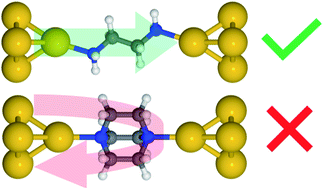
Chem. Sci., 2021,12, 10299-10305
https://doi.org/10.1039/D1SC02287C
A computational and experimental investigation of deep-blue light-emitting tetraaryl-benzobis[1,2-d:4,5-d′]oxazoles
In an effort to design deep-blue light emitting materials for use in OLEDs, the optical and electronic properties of a series of tetraarylbenzobis[1,2-d:4,5-d′]oxazole (BBO) cruciforms were evaluated using density functional theory (DFT) and time-dependent DFT (TD-DFT).
![Graphical abstract: A computational and experimental investigation of deep-blue light-emitting tetraaryl-benzobis[1,2-d:4,5-d′]oxazoles](/en/Image/Get?imageInfo.ImageType=GA&imageInfo.ImageIdentifier.ManuscriptID=D1MA00990G&imageInfo.ImageIdentifier.Year=2022)
Mater. Adv., 2022,3, 3842-3852
https://doi.org/10.1039/D1MA00990G
The synthesis and application of novel benzodithiophene based reactive mesogens with negative wavelength dispersion birefringence
The factors influencing negative wavelength dispersion are investigated for a series of benzodithiophene based photopolymerisable liquid crystals.
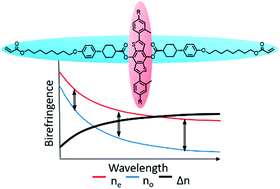
J. Mater. Chem. C, 2021,9, 17419-17426
https://doi.org/10.1039/D1TC05068K
Identifying high-performance and durable methylammonium-free lead halide perovskites via high-throughput synthesis and characterization
The fundamental structure–property relationships in the CsyFA1−yPb(BrxI1−x)3 compositional space are reported.

Energy Environ. Sci., 2021,14, 6638-6654
https://doi.org/10.1039/D1EE02691G
Compositional heterogeneity in CsyFA1−yPb(BrxI1−x)3 perovskite films and its impact on phase behavior
We study the phase behavior of hybrid organic–inorganic metal-halide perovskite and propose a simple method to assess heterogeneity in the <100 nm length scales.
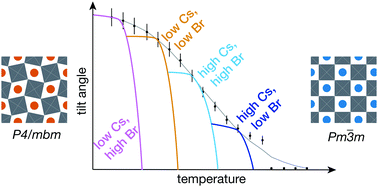
Energy Environ. Sci., 2021,14, 6394-6405
https://doi.org/10.1039/D1EE01184G
Effect of dendron structure on the luminescent and charge transporting properties of solution processed dendrimer-based OLEDs
The energy transfer, PLQY, charge mobility, and OLED performance of blend films of first generation Ir(ppy)3-cored light-emitting dendrimers and dendrimeric TCTA-based hosts are found to be dependent on the dendrons and surface groups used.
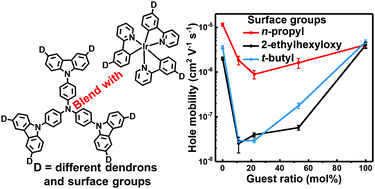
J. Mater. Chem. C, 2021,9, 16033-16043
https://doi.org/10.1039/D1TC03949K
An organotypic model of high-grade serous ovarian cancer to test the anti-metastatic potential of ROR2 targeted Polyion complex nanoparticles
A 3D co-cultured organotypic cancer model to evaluate the anti-metastatic ability of siRNA loaded BSA decorated PICs nanoparticles has been developed.
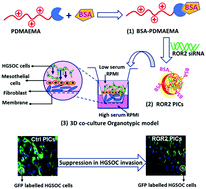
J. Mater. Chem. B, 2021,9, 9123-9135
https://doi.org/10.1039/D1TB01837J
Solid-state near infrared emitting platinum(II) complexes as either an ultrathin or singly doped phosphorescence emitting layer in hybrid white OLEDs exhibiting high efficiency and colour rendering index
Two platinum complexes PBSNND and AtFNND have been used to achieve high efficiency (EQEmax of 12.9% and 13.7%) hybrid white OLEDs with an ultrathin and singly doped phosphorescence emitting layer, respectively.
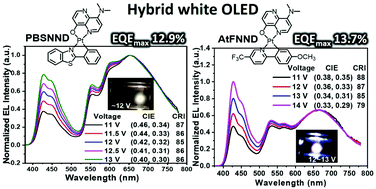
J. Mater. Chem. C, 2021,9, 15470-15476
https://doi.org/10.1039/D1TC03068J
Operation mechanism of organic electrochemical transistors as redox chemical transducers
Designing OECTs to amplify chemical redox reactions reliably requires: (1) separating reaction from the OECT (2) operating the OECT potentiometrically (3) utilizing non-polarizable gate electrode (4) maximizing transconductance of channel material.
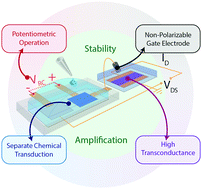
J. Mater. Chem. C, 2021,9, 12148-12158
https://doi.org/10.1039/D1TC02224E
Tailoring oxygen evolution reaction activity of metal-oxide spinel nanoparticles via judiciously regulating surface-capping polymers
It is discovered that the negative effects on OER activity caused by the stabilization of NPs with surface-capping polymers can be mitigated by decreasing the grafting density or increasing the hydrophilicity of the polymer chains.
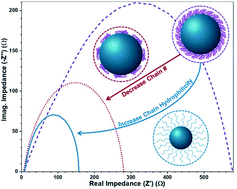
J. Mater. Chem. A, 2021,9, 20375-20384
https://doi.org/10.1039/D1TA04511C
About this collection
During his career, Seth Marder has had tremendous impact as a scientist, as a mentor, as a teacher, and as the founding Editorial Board Chair for Materials Horizons. He has not only made significant contributions to the fields of chemistry and materials science and engineering, but he also greatly impacted students and young scientists from all around the world as a teacher and mentor of science at all levels. With this themed issue and accompanying web collection, we would like to celebrate his commitment to the community and in particular his support towards inclusion and diversity over the last decades, as well as Seth’s strong commitment to the journal itself in his long-standing role as Editorial Board Chair of Materials Horizons over the last 8 years, which was conceived outside of the traditional mold.
On the occasion of Seth’s 60th Birthday, we hope that you will join us in celebrating his achievements and continued contributions to the field by enjoying these articles published in this Festschrift issue of Materials Horizons Guest Edited by Zhenan Bao (Stanford University, USA), Jean-Luc Brédas (University of Arizona, USA), Thuc-Quyen Nguyen (University of California Santa Barbara, USA), and Mark Thompson (University of Southern California, USA), as well as the articles in the web collection, which includes additional contributions from across RSC journals from Seth’s friends and colleagues.